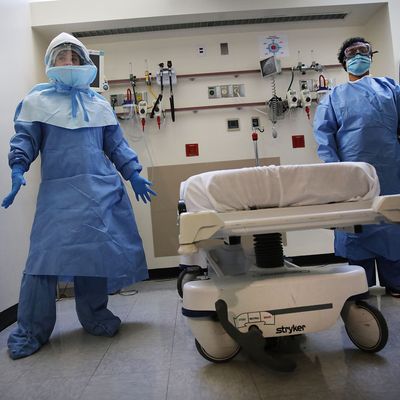
A day after a Dallas nurse became the second person diagnosed with Ebola in the United States, it’s still unclear how she contracted the disease from Liberian patient Thomas Eric Duncan — and the medical community has not taken kindly to the CDC’s suggestion that she was somehow at fault. Daniel Varga, chief clinical officer for Texas Health Resources, said she was following “full CDC precautions,” including wearing a gown, gloves, and a mask, while caring for Duncan, who died Wednesday. However, Dr. Thomas Frieden, who leads the CDC, said on Face the Nation that the fact that Texas Health Presbyterian Hospital hasn’t identified what went wrong “is concerning because clearly there was a breach in protocol.”
The comment exacerbated concerns about whether U.S. hospitals are prepared to handle Ebola patients and whether the problem lies with the recommended procedures or hospital workers failing to implement them. “The care of Ebola patients can be done safely, but it’s hard to do it safely,” Frieden said. “Even a single, inadvertent innocent slip can result in contamination.”
The CDC has been holding conference calls and publishing guidelines on how health-care workers can protect themselves against Ebola, but Bonnie Castillo of National Nurses United said hospitals often just “post something on a bulletin board referring workers and nurses to the CDC guidelines. That is not how you drill and practice and become expert.” A recent survey of 1,900 nurses conducted by the union found that 36 percent feel their hospitals don’t have sufficient supplies — and even if they do, workers may not know how to use the gear without contaminating themselves. Eighty percent said they don’t feel they’ve had adequate Ebola training.
In response to the second U.S. diagnosis, the White House directed the CDC to speed up its investigation of how the nurse contracted the virus and said federal authorities must “take immediate additional steps to ensure hospitals and healthcare providers nationwide are prepared to follow protocols should they encounter an Ebola patient.”
The CDC has already updated its recommendations, saying hospitals should reduce the number of staff treating Ebola patients and cut down on unnecessary procedures. Frieden said that with Duncan, doctors tried unusual and “desperate measures to try to save his life,” such as kidney dialysis and intubation, but “both those procedures spread many contaminants and are high risk.” They say hospitals treating Ebola patients should also have one staffer supervising infection-control measures, and urged facilities to conduct more drills.
Some say the task is so difficult that the CDC should only allow Ebola patients to be treated long-term in the four U.S. facilities — the National Institutes of Health in Maryland, Emory University Hospital in Atlanta, the University of Nebraska Medical Center, and St. Patrick Hospital in Montana — that have special high-containment isolation units. “I don’t think we should expect that small hospitals take care of Ebola patients. The challenge is formidable,” Dr. Dennis Maki, University of Wisconsin-Madison infectious-disease specialist, told the AP.
The CDC said it’s considering that option, though transferring patients is risky. It also doesn’t entirely solve the problem. Every emergency room needs to have some ability to contain the disease because, as Maki noted, “we can’t control where the Ebola patient appears.”






























